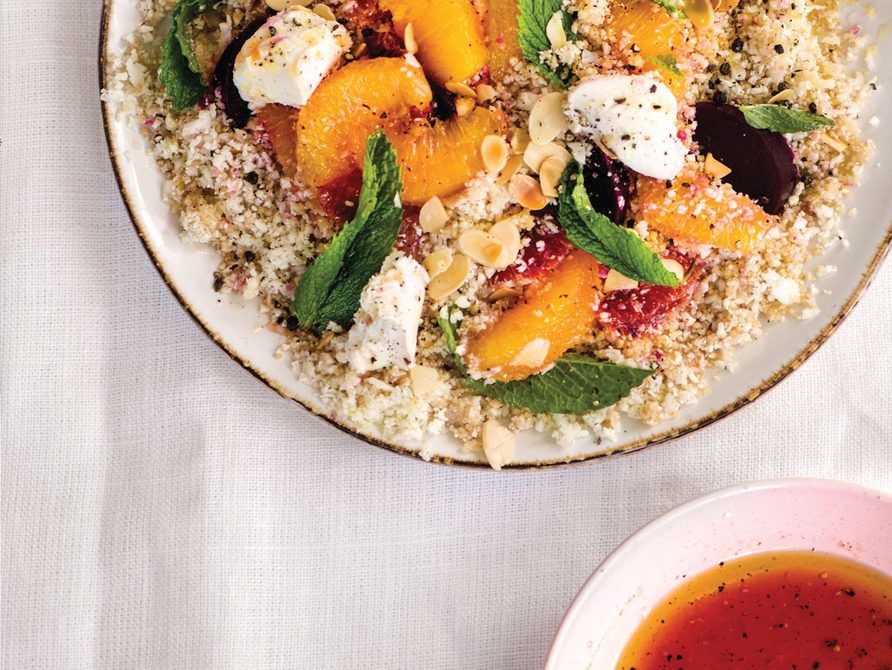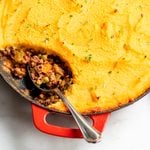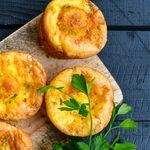An Elegant Side: Brown Butter & Orange Cauli-Couscous Salad
Butter transforms humdrum couscous and its doppelgänger, cauli-couscous, into an tasteful side with jewel-like beets, juicy oranges and tangy goat cheese.
They need to stop writing Disney stories about handsome princes and start writing them about the lifelong companionship a lady can have with good butter. Rich, creamy, and beautifully smooth, butter never disappoints. Nor does it select gardening gear as Valentine’s Day gifts, forget your mom’s name, or leave dirty dishes right beside the sink. (WHY?!) But if we’re talking royalty, brown butter is truly the pleasure king. Cooking butter low and slow allows the moisture to evaporate and the milk proteins to caramelize, leaving behind a nutty, toasty liquid gold that elevates even the humblest fare. Here, it transforms humdrum couscous and its doppelgånger, cauli-couscous, into an elegant side with jewel-like beets, juicy oranges, crisp almonds, and tangy goat cheese.

| Servings |
| 4servings |
| Servings |
| 4servings |
- 3 small red beets
- 1 tbsp fresh lemon juice
- 2 cups cauliflower florets
- 1/4 cup (+2 tbsp) low-sodium vegetable stock
- 1/4 cup orange juice fresh squeezed (about 1 small orange)
- 1 tbsp unsalted butter
- 1/2 cup whole-wheat couscous
- 1 tsp orange zest
- sea salt and cracked pepper
- To serve
- 2 large oranges peeled and segmented (reserve any excess juice)
- 3 tbsp unsalted natural almonds sliced and toasted
- 3 tbsp crumbled goat cheese
- 2 tbsp Fresh mint leaves torn
|
Ingredients
Servings: servings
Units:
|
- Place the beets in a medium saucepan and add enough water to cover and the lemon juice to prevent their pretty colour from bleeding. Bring to a boil over high heat, then reduce the heat to medium-low and simmer, uncovered, for 30 to 45 minutes, until tender. Drain the beets. When cool enough to handle, peel, and slice the beets into wedges (about 8 wedges per beet). Set aside.
- In a small food processor, pulse the cauliflower until it reaches a rice-like consistency. Set aside.
- Pour the vegetable stock and orange juice into a small saucepan and bring to a boil over medium-high heat. Once it begins to bubble, reduce heat to low, cover, and keep warm.
- Meanwhile, heat the butter in a medium saucepan with a light-coloured bottom (so that you can see the colour change) over medium heat. Swirl the pan fairly frequently to make sure the butter cooks evenly. As it melts, it will begin to foam and will progress from yellow to golden to a toasted-brown colour. This should take 2 to 3 minutes. As soon as you see the brown colour and smell a nutty aroma, strain the butter through cheesecloth or simply remove the white bits (milk solids) with a spoon, leaving behind the beautiful nutty oils. Whatever you do, do not wash out the saucepan! Those little caramelized bits on the bottom are culinary gold!
- Return the strained butter to the saucepan over medium-low heat. Immediately add the couscous and stir to coat it in the butter. Stir in the warm orange juice mixture and the orange zest. Turn off the heat, cover the pan, and let stand until the liquid has been completely absorbed, about 5 minutes.
- Add the pulsed cauliflower, cover again and allow the residual heat to warm the cauliflower through for an additional 5 minutes. Fluff the couscous and cauliflower with a fork and season with salt and pepper.
- To serve, transfer the couscous mixture to a large serving bowl. Top with the beet wedges, the orange segments, and any orange juice you collected when segmenting the oranges. Sprinkle with a pinch each of salt and pepper and garnish with toasted almonds, goat cheese, and mint.
Abbey’s tip: Contrary to what our moms were likely taught, new research suggests there is no strong association between saturated fats and cardiovascular disease, and that butter actually increases our “good” HDL cholesterol. Butter’s fatty acid profile includes an anti-inflammatory short-chain fatty acid called butyrate, plus antioxidants, fat-soluble vitamins, and even omega-3 fats! To get the most nutrient bang for your buttery buck, look for grass-fed butter in the store.
Excerpted from The Mindful Glow Cookbook by Abbey Sharp. Copyright © 2018 by Abbey Sharp. Photography by Kyla Zanardi. Published by Penguin Canada, a division of Penguin Random House Canada Limited. Reproduced by arrangement with the Publisher. All rights reserved.




